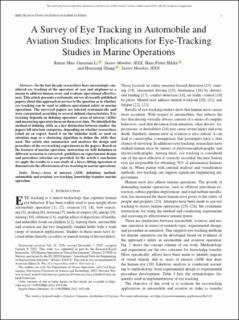| dc.contributor.author | Mao, Runze | |
| dc.contributor.author | Li, Guoyuan | |
| dc.contributor.author | Hildre, Hans Petter | |
| dc.contributor.author | Zhang, Houxiang | |
| dc.date.accessioned | 2021-04-20T14:25:06Z | |
| dc.date.available | 2021-04-20T14:25:06Z | |
| dc.date.created | 2021-02-10T12:57:08Z | |
| dc.date.issued | 2021 | |
| dc.identifier.citation | IEEE Transactions on Human-Machine Systems. 2021, . | en_US |
| dc.identifier.issn | 2168-2291 | |
| dc.identifier.uri | https://hdl.handle.net/11250/2738724 | |
| dc.description.abstract | In the last decade researchers have increasingly considered eye tracking of the operators of cars and airplanes as a means to address human error and evaluate operational effectiveness. This article presents a systematic survey of recently published papers about this approach in service to the question as to whether eye tracking can be used to address operational safety in marine operations. The surveyed papers are selected systematically and were categorized according to several defined characteristics. Eye tracking depends on defining operators’ areas of interest (AOIs) and measuring operators focus on them over time. We identified the method of defining AOIs as a key distinction between studies; the papers fell into four categories, depending on whether researchers relied on an expert, based it on the stimulus itself, or used an attention map or a clustering algorithm to define the AOIs they used. The article also summarizes and analyzes the design and procedure of the eye-tracking experiments in the papers. Based on the features of marine operation, instruction on AOI definition in different scenarios is extracted; guidelines on experimental design and procedure selection are provided. In the article's conclusion we apply the results to a case study of a heavy-lifting operation to demonstrate the effectiveness of eye-tracking in marine operations. | en_US |
| dc.language.iso | eng | en_US |
| dc.publisher | IEEE | en_US |
| dc.rights | Navngivelse 4.0 Internasjonal | * |
| dc.rights.uri | http://creativecommons.org/licenses/by/4.0/deed.no | * |
| dc.title | A Survey of Eye Tracking in Automobile and Aviation Studies: Implications for Eye-Tracking Studies in Marine Operations | en_US |
| dc.type | Peer reviewed | en_US |
| dc.type | Journal article | en_US |
| dc.description.version | publishedVersion | en_US |
| dc.source.pagenumber | 12 | en_US |
| dc.source.journal | IEEE Transactions on Human-Machine Systems | en_US |
| dc.identifier.doi | 10.1109/THMS.2021.3053196 | |
| dc.identifier.cristin | 1888507 | |
| dc.relation.project | Norges forskningsråd: 237929 | en_US |
| dc.relation.project | EC/H2020/826452 | en_US |
| dc.description.localcode | Open access. Published by IEEE. | en_US |
| cristin.ispublished | true | |
| cristin.fulltext | original | |
| cristin.qualitycode | 1 | |

